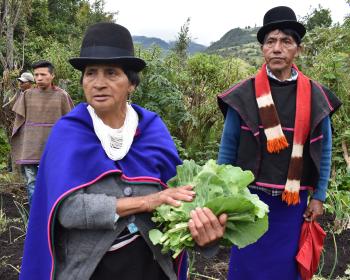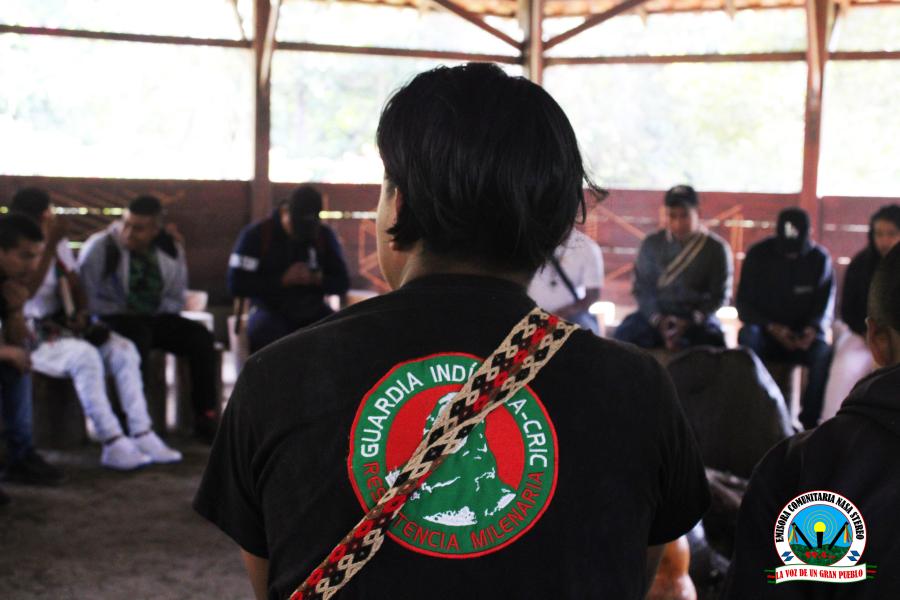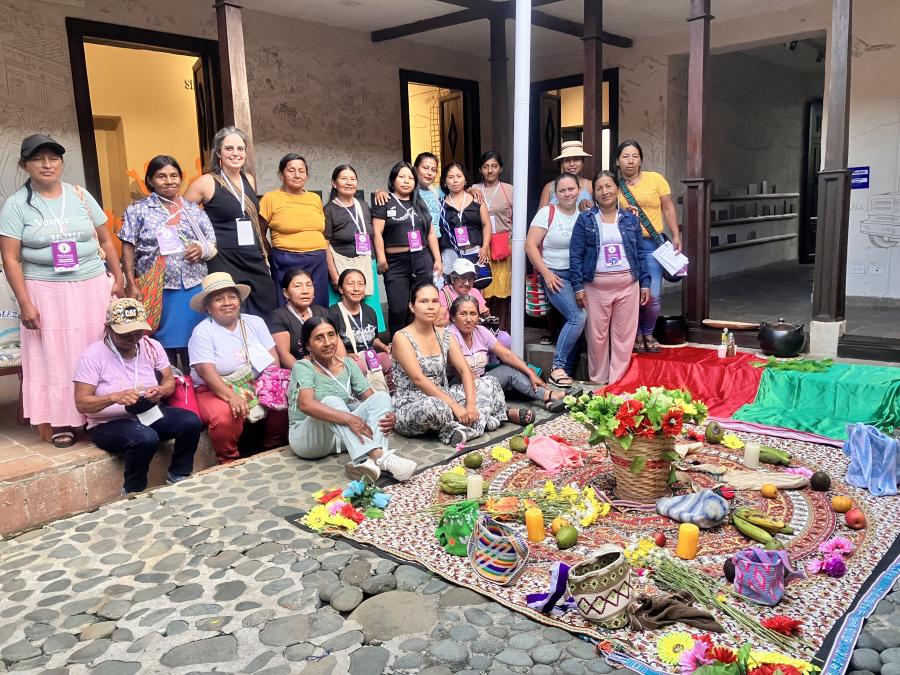In May the North Shore Colombia Solidarity Committee (NSCSC) in Salem, Massachusetts, hosted Remedios Fajardo, an indigenous Wayúu who in 1982 founded the indigenous rights organization Yanama in the Colombian Guajira, and Armando Pérez Araujo, a lawyer who has worked for the past decade defending communities in the Guajira affected by the Cerrejón Zona Norte coal mine. This visit was particularly poignant for both sides, because the Salem Harbor Power Station is one of several in the United States that purchase coal from the Cerrejón Zona Norte mine.
The event was a rare opportunity for U.S. consumers to hear first-hand the story of those affected by U.S. corporations operating abroad. Educating people about this connection was a major motive for the formation of the NSCSC in early 2002. The group hoped—correctly, it turned out—that Massachusetts residents would feel more compelled to care about the situation if they knew that their actions in Salem had a very direct effect on people in Colombia.
The Coal Mine in Colombia
Construction on the Cerrejón Zona Norte mine began in 1980 as a joint venture between Carbocol, the Colombian government coal company, and Intercor, a fully owned subsidiary of Exxon. By the 1990s it had become the largest open-pit coal mine in the world, occupying a 30-mile by five-mile area and transporting coal to a private port 95 miles away on a company railroad. In October 2000 an international consortium, consisting of the Anglo-Australian Billiton Company, South Africa’s Anglo American Corporation, and Switzerland’s Glencore International AG, purchased Carbocol’s share of interest in the mine for about $384 million; in early 2002 the consortium purchased the remaining half from Intercor.
Coal mining in the Guajira peninsula has severely disrupted the lives of the Wayúu people, an indigenous group of approximately 120,000 who have lived in the northern borderlands of Colombia and Venezuela (including on the Guajira peninsula), since before the Spanish conquest. Over the centuries, the Wayúu’s territory has shrunk and they have been pushed out of the more fertile southern Guajira lands into the dry deserts of the northern Guajira. Despite centuries-long contact that included Wayúu involvement in the smuggling trade and continued Western encroachment on their ancestral lands, the Wayúu remained an ethnically, culturally, and linguistically distinct group—the largest in Colombia.
The mine affected the Wayúu in many ways. First, it took over tens of thousands of hectares of land in the southern Guajira. Dust, blasting, and contamination also made surrounding areas uninhabitable. Over the two decades of its existence, the mine has continued to expand, destroying farms, water sources, and towns. In 1992, London-based Survival International named Exxon one of the top-10 corporate violators of indigenous rights worldwide, citing the company for its oil drilling activities in Alaska and the Northwest Territories, and also “for massive coal dust pollution from its open pit mine on the land of the Wayúu Indians.” A Wayúu resident of Tamaquito, a village a few kilometers from the mine, testified in 2000: “Here there is plenty of water, but there is no work. The company has bought almost all of the farms; it’s impossible to plant, or pasture, or hunt. Towns like Tabaco, where we used to work as temporary day laborers, have been depopulated. There is no work, there are no schools, there are no neighbors. We are alone and isolated. That’s why we are leaving.”
The construction of the mine also had secondary effects that spread geographically far beyond the mine itself. The Wayúu are “poly-residential.” Members of matrilineal Wayúu clans have historically maintained residences in various parts of the peninsula, as well as in farming and industrial areas in Colombia and Venezuela. They migrate periodically as herds follow water and humans follow wage labor. By declaring the land of the northern Guajira baldío, or untitled, the government implied that it was uninhabited and allowed the mining companies to disrupt patterns of residence and migration. The railroad cut through the dry northern Guajira, the heartland of Wayúu territory. At a meeting in Wisconsin in 1996, a Wayúu representative described the impact of the mine on his people: “The construction of the mine had a devastating effect on the lives of approximately 90 Wayúu apushis (matrilineal kinship groupings) who saw their houses, corrals, cleared ground, and cemeteries flattened for the construction of a road from El Cerrejón to the new port of Puerto Bolivar, with no respect for indigenous rights. The excavation of the open pit has also caused the adjoining rivers and streams to dry up, along with people’s drinking wells.”
Finally, the mining complex brought thousands of non-Wayúu workers to the region from other parts of Colombia. During the construction phase, many Wayúu were promised employment at the mine. Once it opened for operation, however, the highly mechanized facility preferred to hire skilled workers from elsewhere in the country. A 2001 report documented the depressingly predictable long-term effects of the mine on the Wayúu communities: the proliferation of alcoholism and prostitution, the loss of sacred spaces, a rise in death rates due to poisoning and contamination from the mine and its wastes, a loss of cultural integrity and identity, and increasing poverty.
Yanama was the first cross-clan Wayúu organization, and was created in large part to develop a collective response to the mine’s threats. By the 1990s, Yanama was represented in the United Nations Working Group on Indigenous Populations. Yanama has worked on ethnic issues like bilingual and bicultural education (in a region where more than half the population has had no access to schooling), but it has also crossed ethnic lines to unite the Wayúu with non-indigenous peoples who are also threatened by the mine. In 1992, Yanama worked with Armando Perez Araujo, the lawyer representing the towns of Caracolí and El Espinal, to bring a suit against the Colombia Ministry of Health because the contamination of coal and other dust, and the constant noise of the machinery, were prejudicial to residents’ health. He argued that the ministry had, in February 1991, declared a 1,000-meter strip to be “uninhabitable,” and a 4,500-meter area “dangerous” because of the contamination, but had not taken any action to protect the residents, who included both Wayúu Indians and peasant farmers. Yanama had prepared a 16-page study documenting the effects of pollutants and arguing that between 1984 and 1991 the health of the community had deteriorated significantly—24 deaths (out of a combined population of about 350) had been caused by exposure to toxins from the mine. After several appeals, the court ruled in favor of Yanama and ordered the Ministry of Health and the Ministry of Mines and Energy to rectify the situation by requiring the mining company coalition to guarantee the protection of the inhabitants of these towns. However, in collaboration with the head of the Office of Indigenous Affairs of Uribia, the company’s “solution” was to remove people from their homes and place them on lands designated as indigenous resguardos (reservations).
In the late 1990s, Yanama representatives contacted the London-based organization Partizans (People Against Rio Tinto and its Subsidiaries; at the time Rio Tinto had a share in the Cerrejón Central mine), and in October 2000 Partizans members Roger Moody and Richard Solly traveled to Guajira to investigate conditions in communities surrounding the mine. They found that the towns that had protested the effects of the mine in 1992 no longer existed. Manantial and Caracolí had been dispersed by violence; at the Viejo Oreganal mine (near Cerrejón Central), residents were pressured to sell their land as Rio Tinto, Billiton, and Glencore purchased surrounding pasture and destroyed the church, school, and community center. At Espinal, police had ordered residents to relocate without warning to a new site at Rio de Janeiro; those who refused were forcibly removed.
The pattern seems consistent: First, blasting, dust, and contamination make life unpleasant; then pasture land disappears, and harassment of residents follows; finally, if residents refuse to leave, forcible eviction destroys the community.
In May 2001, Pérez Araujo attended a meeting in London as one of several representatives of Yanama. The declaration that emerged from the meeting—signed by delegates from 23 countries—read in part:
We have seen our peoples suffering for many years from mining in all stages and forms, and from exploration to development through to abandonment. Industrial mining has caused grievous pain and irreparable destruction to our culture, our identities, and our very lives. Our traditional lands have been taken, and the wealth seized, without our consent or benefit.
Invariably mining imposed upon our communities has poisoned our waters, destroyed our livelihoods and our food sources, disrupted our social relationships, created sickness and injury in our families. Often our communities have been divided by ‘imported’ civil conflicts. Increasing mechanization has denied many of us a role we once had as mineworkers.
At the time of this writing, the Afro-Colombian town of Tabaco and its smaller neighbor, the Wayúu town of Tamaquito, are threatened. According to Solly and Moody, residents of Tabaco complained in early 2001 that “their houses are cracking up because of blasting from the mine and that their main water source is polluted with coal dust. Pasture land is being lost as mining operations come closer. Many villagers have already left.”1
Residents were particularly distressed at the apparent collusion between the company, the government, and the Catholic Church. The priest, Marcelo Graziosi, agreed to sell the church—which had been built by the community—for 38 million pesos ($16,550). Tabaco residents appealed in vain to the priest in Hatonuevo and to the bishop. The government closed the school (though a volunteer teacher continued to give classes in the building) and the health center.
In June 2001, two Wayúu journalists, the president of Tabaco’s Community Action Group, a community resident, and a volunteer teacher were accosted by company police while attempting to document company measures aimed at destroying the community. The security agents confiscated the film, stating that “the film must be for the guerrillas,” and beat and arrested the five people.
On August 9, 2001, private and public police arrived with bulldozers to destroy Tabaco. Several video photographers documented the destruction and its aftermath. Tamaquito now fears that it is doomed to the same fate.
Seeking Solidarity in Salem
At an Exxon shareholders’ meeting in the United States in late May 2002, Armando Pérez Araujo and Remedios Fajardo presented testimony as representatives of Yanama. Their trip to Salem, Massachusetts, put them in touch with consumers of the Cerrejón mine’s coal. Prior to their visit, NSCSC circulated the videotape of the destruction of Tabaco to local cable television stations and public meetings to build a base of awareness.
While in Salem, Armando and Remedios met with college, high school, and community audiences, as well as with the mayor of Salem, city council members, and the local newspaper. Members of HealthLink, a local environmental organization working to clean up the coal-fired power plant, were particularly interested in learning more about the coal mining—they knew its effects in the United States only too well. Representatives of Pacific Gas and Electric Company, which owns the power plant, refused to meet with the Armando and Remedios, but Mike Fitzgerald, general manager of the plant, issued a statement that said, “As a customer, we urge our vendor to enter into negotiations and find a just settlement on this issue.” Salem’s mayor promised material and moral support for the village of Tabaco, and the city council passed a resolution calling on the mining companies to carry out “peaceful and just negotiations that guarantee residents in the mining area basic human rights.”
The resolution concluded:
As a community hosting a coal powered-generated facility, we condemn violations of human rights by all actors involved in Colombia’s conflict, including guerrilla groups, military, paramilitary, police, multinational corporations, and foreign agents, including U.S. defense contractors; we express our solidarity with all Colombians working for nonviolent, just, political solutions to the conflict in Colombia; and we encourage the establishment of an ongoing relationship with organizations in the Guajira working peacefully for the human and democratic rights of the Wayúu indigenous people (Yanama) and the villagers of Tabaco (Comité Pro-Reubicación de Tabaco).
Remedios and Armando felt that focusing international attention on their struggle would provide their best hope for achieving their goals. In the short run, these goals include giving villagers from Tabaco and Tamaquito a voice in negotiating with the mining companies rather than being subject to destruction and eviction. In the long run, their goals include allowing human and indigenous rights activists a stronger role in the region, and limiting the ability of the companies to intimidate and silence them.
Remedios and Armando were heartened and grateful to learn that coal consumers do care—if they have the chance to find out—about the lives of those residing where their coal originates.
1. Solly, R., and Moody, R. (2001, January). Background: Stripping the Guajira Bare.
Aviva Chomsky (achomsky@salemstate.edu) is professor of history and coordinator of Latin American, Latino, and Caribbean Studies at Salem State College in Massachusetts. Her research has focused on the impact of multinational investors on local communities in Latin America. She is currently researching foreign-owned coal mines in Colombia and working with displaced communities in the Guajira.
References & futher reading
Updates on the situation in the Guajira are regularly posted on the Mines and Communities website in the Action section.
Pacini Hernandez, D. (1984). Resource Development and Indigenous People: The El
Cerrejón Project in Guajira, Colombia. Cultural Survival Occasional Paper 15.
Rivera Gutiérrez, A. (1984). Exxon and the Guajiro. Cultural Survival Quarterly 8. Pp 72-74.
Roston, Aram. (2001, September 3). It’s the Real Thing: Murder, The Nation.
Pressure Point (2002). Destruction of Tabaco. Seattle: Pressurepoint.
Webster, David (1992, October). In the Steps of Columbus: Corporate Land Theft. The ACTivist 8:10,
Weidler, Guerra Curvelo (2000, November). Informe sobre el establecimiento de la pertenencia étnica de los habitantes del asentamiento rural de Tamaquito-Municipio de Barrancas-Departamento de la Guajira. Santa Fe de Bogotá: DGAI.
Gedicks, Al (1997). War on Subsistence: Mining Rights at Crandon/Mole Lake, Wisconsin. In Life and Death Matters: Human Rights and the Environment at the End of the Millennium. Johnston, Barbara Rose, Ed. Lanham, Maryland: Alta Mira Press.
Fajardo Gómez, Remedios (2001, August 9). Violación sistemática de los derechos humanos. Unpublished paper.
Corte Constitucional de Colombia (1992, September 18). Relatoría 11, Sentencia No. T-528.
Perez Araujo, Armando, et al (2001, September). The London Declaration. Mines and Communities
Solly, Richard and Moody, Roger (2001, August). Urgent Action on Crisis Involving Exxon in Colombia. Mines and Communities.
Solly, Richard and Moody, Roger (2001, July). Solidarity with displaced communities in La Guajira in Colombia. Freeteam internet posting.
Solly, Richard and Moody, Roger (2001, October/December). Exxon subsidiary Intercor attacks community at Tabaco again. Mines and Communities.



